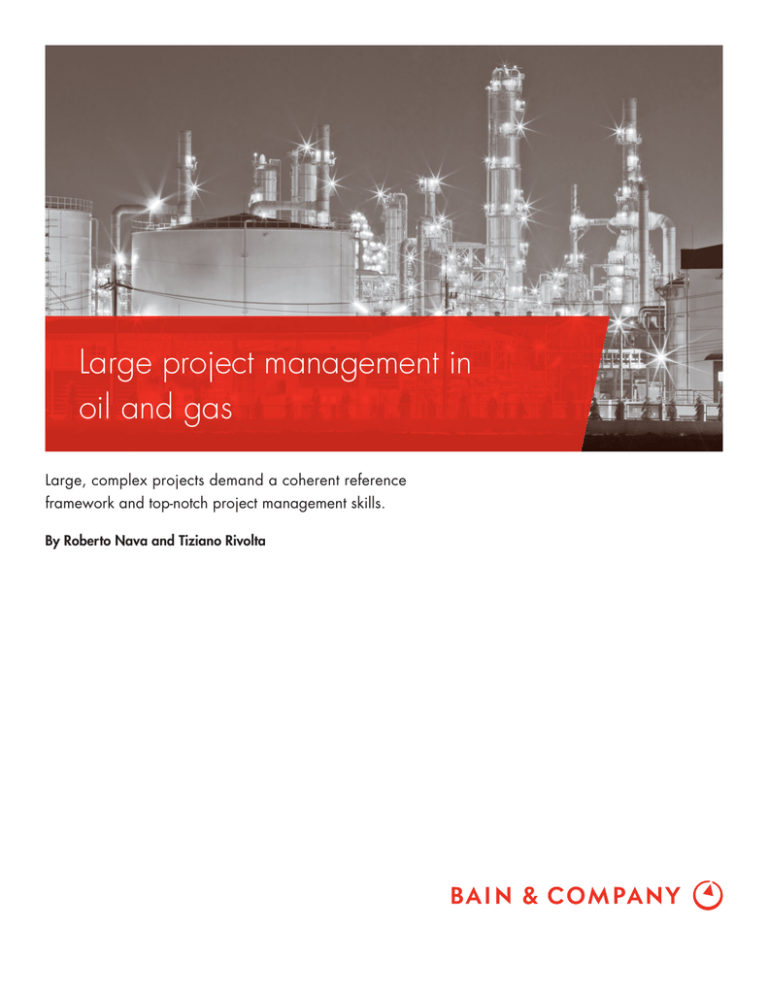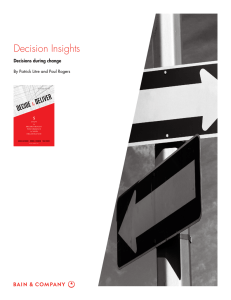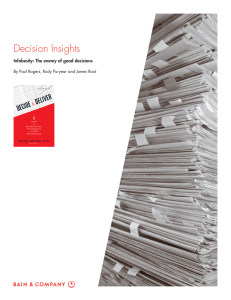
Large project management in
oil and gas
Large, complex projects demand a coherent reference
framework and top-notch project management skills.
By Roberto Nava and Tiziano Rivolta
Roberto Nava and Tiziano Rivolta are partners with Bain & Company in Milan.
The authors would like to acknowledge the contributions of Max Panaro and
Giacomo Franchini, both with Bain & Company in Milan.
Copyright © 2013 Bain & Company, Inc. All rights reserved.
Large project management in oil and gas
•
Rome wasn’t built in a day; it grew through a series of
large projects, managed to schedules and budgets.
Consider the Colosseum: An army of workers took less
than 10 years to complete it in 80 AD, using 100,000
cubic meters of travertine marble. To accomplish this,
project leaders relied on tested engineering concepts
and organizational innovations.
•
The amphitheater was divided into sectors, assigned
to different contractors and supervised by teams
of civil engineers, who shared best practices and
guaranteed results.
•
Contractors followed prescribed practices for simple
designs, to deliver against cost and time goals. Roman
engineers set a very high bar for innovations.
•
Successful companies also continuously improve their
general project management skills, as well as skills
specific to oil and gas. A shortage of technical talent in
the industry—destined to become more acute over the
next seven years as a generation of experienced engineers retires—complicates the problem. Even so, as
they approach projects of greater complexity and scope,
companies cannot afford to bring second-rate talent to
the game.
The challenge of large projects
As activity ramps up and more oil and gas production
moves to frontier and unconventional resource areas,
projects are becoming larger and more complex. These
include an offshore facility in the Arctic, budgeted at
more than $3 billion, and an $8.4 billion petrochemical
complex spread across 45 kilometers in South America.
Such projects involve many stakeholders, including
shareholders, local authorities and regulators, and environmental and community advocates. Schedules are
compressing, too: For one oil company, more than 90%
of its field discoveries from 2009 to 2011 are due online
in less than eight years.
Engineers managed the organizational and logistical complexities in the design phase. For example,
working space on site was maximized and many
activities were outsourced to yards where partly
assembled blocks were prepared.
Today, large projects in the oil and gas industry face
similarly daunting challenges as they become increasingly complex and technologically demanding. Schedules and budgets are tight, safety is crucial and every
project faces a network of stakeholders concerned about
its impact on the environment and communities. Even
so, today’s project managers still rely on concepts that
the builders of the Colosseum, as well as other large
projects of antiquity, such as the Pyramids of Giza and
the Great Wall of China, would recognize: work breakdown plans, design-to-cost and make-or-buy decisions.
Of course, no company manages only one project at a
time. Firms’ portfolios may include hundreds of complex projects, which they prioritize not only on financial
goals and risks (including execution, commercial, healthsafety-environmental [HSE] and reservoir risks), but
also increasingly based on the availability of scarce resources like engineering talent. Some are building up
their internal engineering staffs by as much as 80% to
effectively manage the many contractors and suppliers
on each project.
Our experience working with projects in oil and gas
suggests that while best practices and experienced talent
are essential, they are not enough. Successful managers
of large projects follow a coherent, consistent reference
framework that guides their decisions and processes.
These frameworks include:
•
Formalized project phases and checkpoints
•
Clear accountabilities within an integrated
project team
•
Checks and balances between central functions
and project teams
Continuous review to measure project value and
monitor risk
Scoping projects accurately is an important skill. For
small companies, delivery of a smaller, technically complex project may be as demanding as larger projects are
for large companies. However, projects that look very
big (for example, upstream shale production projects)
may in fact be a collection of smaller projects. Companies
that approach their unconventional strategy in the same
way they would approach a large, complex project run
the risk of over-engineering their upstream production
if they treat many small projects like a large one.
1
Large project management in oil and gas
A framework to meet these challenges
Leaders also work to control costs in the early architectural and planning phases, when key decisions are
made. Typically, 80% to 90% of costs are incurred in
later phases.
Following a robust project reference framework can help
avoid cost and schedule overruns. Leading companies
gather technical input early, incorporating it into the
project’s framework to make sure it aligns with the organization’s larger goals. They also engage stakeholders
throughout the life of the project, from architecture and
design through execution.
Well-managed large projects balance simplicity and
flexibility with respect for rigor at checkpoints. While
it’s important to keep project teams on task and schedule, processes that are not easily changeable can place
unnecessary hurdles in a project’s path.
Formal project phases and checkpoints. Decision checkpoints, or stage gates, mark the end of formal project
phases (see figure). To move from one stage to the
next, managers, coordinating with stakeholders, have
to decide if they are ready to move on.
Clear accountability in an integrated project team. Successful projects require effective decision making. Our
analysis of projects that run late or over budget finds
the top reason is “not making good decisions with the
right people and not making them happen.” This may
include failing to invite technical input at the concept
phase, disregarding stakeholders or misaligning decision makers’ incentives and project goals.
To keep these stage gates relevant, leading oil and gas
companies and the contractors who work with them
continuously revise their stage-gate frameworks to align
them with evolving market conditions. They anticipate
the needs of key stakeholders as they plan the steps
toward completion. For example, it may make sense to
define local content requirements well ahead of frontend engineering design.
An integrated project team with clear roles and responsibilities, and a shared interest in the project’s objectives, helps ensure accountability. In some organizations
where decisions and accountability are not clearly allo-
Figure: Typical phases and stage gates of a major oil and gas infrastructure project
Project architecture
Objective
Gate
1
Gate
2
Detailed planning
Choose the project
Define the concept
Define the sources of value
Evaluate the alternatives
Identify any constraints
Choose the best concept
based on evaluation of risks
• Create a strategy
• Produce an execution plan
• Collect bids
•
•
•
•
Stage-gate
question
Is this the best way
to maximize the
project’s value?
Execution
Execution and start-up
• Manage the project
within cost, time and
quality targets
• Effectively manage
variances
Gate
3
Completion
Gate
4
Performance test
• Achieve expected results
• Make a plan to maintain
performance and deliver
maximum return to
stakeholders
Did we achieve the
project’s goals?
Can we successfully
execute the project
and create value
for stakeholders?
Is the asset ready
for production?
Can operations
proceed efficiently?
What lessons did we learn?
Key
• Understand sources of value
deliverables • Build a system to monitor
constraints
• Agree on a consolidated plan
• Obtain approval
• Project plan: front-end
engineering and
design (FEED)
• Assign contracts
• Commissioning
• Start-up
Source: Bain & Company
2
• Performance tests
• Evaluate project
• Handover to operations
Large project management in oil and gas
cated to project teams, functional experts may wind up
making key decisions. That can create bottlenecks and
delays, as decisions percolate up to functional managers with wide-ranging agendas. A diagnostic survey of
decision quality, speed, yield and effort can identify
areas that need to be changed.
against objectives. Failing to plan for these contingencies can delay a project and send it over budget.
Successful project managers seek to understand the host
country’s goals. They engage policy makers to create
long-term strategies that go far beyond their immediate
supplier needs, promoting best practices that help local
industries meet global standards. A local network of
robust suppliers not only benefits the project, but also
the local economy.
Checks and balances between central functions and
project teams. Corporate functions empower project
teams by staffing the best people, defining processes
and ensuring control of managerial and technical activities. In turn, project teams must be able to make the
decisions for the projects’ deliverables. Projects are more
likely to succeed when the functional experts have an
advisory rather than a decision-making role in assurance,
control and steering activities.
Engineering. Over-engineering can contribute to unnecessary complexity in major projects, while simplicity
in design can ensure efficient and competitive solutions.
This is an ancient principle: Even the engineers supervising the construction of the Colosseum demanded
simple, proven construction techniques, setting a high
bar of proof for any deviation that strayed from their
templates. Today’s oil and gas projects can benefit from
the same principles. At one project, engineers reviewed
71 complex engineering actions, from rotating machinery to the layout of pipes, to find simplifications that
saved between 1% and 2.5% of costs.
Continuous review to measure project value and monitor risk. Successful organizations assess projects continually, not only at formal checkpoints and stage gates,
to ensure they are on track to add value. Ideally, senior
managers who are not part of the project team give a
“cold eye” review of the project, costs and progress.
They report to decision makers on the project’s state
of readiness and suggest ways to improve value or cut
costs. Comparing the project with others in the portfolio
helps prioritize resources in line with company goals.
Sometimes the reviewer’s analysis will lead the organization to modify a project or change its delivery date.
Competency development across capabilities
International oil companies (IOCs) and oil field service
companies are building up their internal engineering
capabilities to ensure quality among their contractors.
This enables them to better manage projects for national oil companies (NOCs) and other resource holders
(see the Bain Brief “National oil companies reshape the
playing field” for more on this trend).
A good framework is essential, but it’s not enough to
satisfy the demands of major projects in oil and gas. Companies must also continuously improve their general
project management skills, balancing trade-offs among
costs, schedules, technical demands and stakeholder
requirements while also coordinating between the functional center and project teams (see the sidebar, “Managing large capital projects,” for a complete list).
Procurement. Many oil companies are rationalizing
their procurement relationships, moving from many
shallow relationships to fewer but deeper ones. For example, some IOCs are trying to spend half their procurement budget with their top 40 vendors, whereas a
few years ago that share might have gone to more than
250 companies. Taken as a whole, these improvements
could return 5% on cost efficiencies.
In oil and gas, some skills areas are particularly important:
Procurement trends follow cycles, however, and the
push for local content requirements could fragment
the procurement pool again. If local content efforts are
to succeed over the long term, NOCs and other oil and
gas companies will have to work with local suppliers
to build a strong foundation of support services (see
the Bain Brief “How national oil companies can fuel
economic development”).
Local content. Local content rules, which require large
project owners to source some goods and services from
the host country, are critical in oil and gas projects.
Project managers must understand the requirements
and plan accordingly, taking into account the relevant
risks. In some cases, services are not available from
local sources, or local providers are not able to deliver
3
Large project management in oil and gas
Managing large capital projects
Successful project managers rely on a collection of essential skills:
Project management: Manage trade-offs among costs, schedule, technical solutions and stakeholder
requirements to ensure the project’s value
Local content and other stakeholders: Ensure proper alignment with stakeholders while meeting
requirements to use local content and contractors
Costs and schedule: Provide an accurate estimate and control of project results, from concept to
completion, monitoring project costs and schedule
HR and support functions: Manage resources, training and compensation to ensure that the necessary
skills are available to the project when needed
Production operations: Take into account all aspects of the asset’s operability and maintenance, from
planning through commissioning, start-up and performance tests
Engineering: Identify technologies that deliver innovation and competitive advantage in terms of
quality, costs and schedule while avoiding over-engineering
Procurement: Source goods and services based on best market opportunities
Contracting: Define and manage contracts to meet quality, costs and schedule requirements
Risk and opportunity management: Minimize the probability and consequences of threats while
maximizing opportunities in a systematic and constantly updated process
Quality and HSE (health, safety, environment): Guarantee the health and safety of employees,
contractors, customers, local communities and the environment throughout the project life cycle
Better tools can also improve procurement. One company redefined its contract work breakdown into related
contracting modules, allowing it to reassign some contractor jobs and save 13% on goods and services. Global
companies should also strive to manage suppliers at the
global level and ensure they’re working with the supplier’s
A team, which adds value (and reduces frustration).
Leading companies work with contractors to determine
how risk and opportunity will be shared. This can forge
a much closer relationship than simply trying to transfer risk to contractors while reducing cost and risk for
the managing organization.
Engineers and builders in the oil and gas industry face
daunting and unprecedented challenges as they design
and construct the infrastructure to extract and process
the resources that will power the global economy over
the next few decades. Few large projects in the planning
stages will stand the test of time like the Colosseum.
But that doesn’t diminish their importance or suggest
they should be undertaken with any less rigor. As the
oil and gas industry embarks on a new generation of
major projects, project managers will need to rely on
coherent, consistent reference frameworks that guide
their decisions and engage the most competent talent
they can find in order to keep pace.
Risk and opportunity. Managing risk and opportunity
is a continuous process that requires companies to consider not only the most common risks, but also to have
experience mitigating unexpected events. In the oil and
gas industry, it’s never been more important to manage
health, safety and environmental risks, given the rising
complexity of operations and the close scrutiny by regulators and stakeholders. Risk identification and evaluation is a continuous process throughout a project’s
life cycle and across the project portfolio, taking a systemic perspective that considers projects, their phases
and relevant risks.
4
Shared Ambit ion, True Results
Bain & Company is the management consulting firm that the world’s business leaders come
to when they want results.
Bain advises clients on strategy, operations, technology, organization, private equity and mergers and acquisitions.
We develop practical, customized insights that clients act on and transfer skills that make change stick. Founded
in 1973, Bain has 48 offices in 31 countries, and our deep expertise and client roster cross every industry and
economic sector. Our clients have outperformed the stock market 4 to 1.
What sets us apart
We believe a consulting firm should be more than an adviser. So we put ourselves in our clients’ shoes, selling
outcomes, not projects. We align our incentives with our clients’ by linking our fees to their results and collaborate
to unlock the full potential of their business. Our Results Delivery® process builds our clients’ capabilities, and
our True North values mean we do the right thing for our clients, people and communities—always.
Key contacts in Bain’s Global Oil & Gas practice:
EMEA:
Juan Carlos Gay in London (juancarlos.gay@bain.com)
Christophe de Mahieu in Dubai (christophe.demahieu@bain.com)
Roberto Nava in Milan (roberto.nava@bain.com)
Peter Parry in London (peter.parry@bain.com)
Tiziano Rivolta in Milan (tiziano.rivolta@bain.com)
Luis Uriza in London (luis.uriza@bain.com)
Americas:
Riccardo Bertocco in Dallas (riccardo.bertocco@bain.com)
Pedro Caruso in Houston (pedro.caruso@bain.com)
Jorge Leis in Houston (jorge.leis@bain.com)
Rodrigo Mas in São Paulo (rodrigo.mas@bain.com)
Ethan Phillips in Houston (ethan.phillips@bain.com)
José de Sá in São Paulo (jose.sa@bain.com)
Asia-Pacific:
Sharad Apte in Bangkok (sharad.apte@bain.com)
Francesco Cigala in Kuala Lumpur (francesco.cigala@bain.com)
John McCreery in Singapore (john.mccreery@bain.com)
For more information, visit www.bain.com









